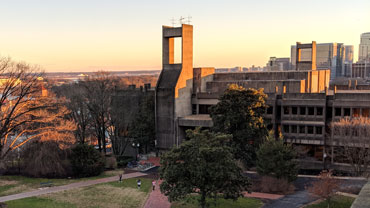
With more than 3 million books; an exceptional collection of scholarly databases, journals, archival materials; and a host of academic and research services, the Library is here to support you during your time at Georgetown. Here are some steps you can take today to start to take advantage of everything the Library has to offer.
- Meet your research services librarian: The Library’s research librarians can partner with you on your own research and support your teaching. Librarians teach course-specific resources and research strategies, provide one-on-one research consultations to help both students and faculty find the resources they need, collaborate with you to craft research assignments that develop student research skills, come to your class and be present in Canvas or your course website, and create specific subject and course guides and tutorials geared to your course needs.
- Visit the Library’s faculty homepage: The Library offers hundreds of resources and services to support your research and teaching, and the best place to find them is at library.georgetown.edu/faculty. The faculty homepage provides an overview of these resources and services, and information on how to contact us if you want more information about anything.
- Follow the Library: Keep up-to-date on the latest news and information from the Library by following us on Twitter, Instagram, and Facebook. We regularly post news, alerts, and lots of interesting Georgetown history. Don’t miss out!
- Request course reserves: If you haven’t already, submit your course reserve requests so we can get them ready for your students. Many items can be made available through the Library website, Box, and Canvas—including streaming media.
- Explore the Booth Family Center for Special Collections: The Library’s Booth Family Center for Special Collections is home to the University Archives, Rare Books, Manuscripts, and the University Art Collection, all of which are available to be used in your courses and research. The best place to start exploring the BFCSC is with the Special Collections catalog or the search box on our homepage. Most of our rare books are also listed in HoyaSearch, and you can also find descriptions of many items from the Archives and Manuscripts in DigitalGeorgetown. Booth staff are always available to discuss resources in your area and talk with you about bringing your class to the Barbara Ellis Jones Inquiry Classroom, which is designed specifically for teaching with rare and valuable items.
- Attend a Library workshop: Our fall workshop schedule includes sessions on research skills, digital mapping, data analysis and visualization, podcasting, video production, Maker Hub tools and technologies, and more. All workshops are free to the Georgetown community. See the full schedule.
- Learn about Digital Scholarship Services: The Library’s Digital Scholarship Services team can help support teaching and research in a wide range of areas including data analysis and visualization, GIS, media production, data management, and digital publishing. Digital Scholarship Services staff can also help you incorporate digital projects into your courses and can guest-teach a lesson on a variety of digital tools.
- Break through journal and database paywalls: Install Lean Library, a browser extension that will allow you to access paywalled research journals and databases that the Library subscribes to—even if you’re not on campus or not finding them through the Library’s website.
- Investigate Open Access: The Library has a contract with Cambridge University Press that allows any Georgetown faculty, staff, or student to publish open access articles in CUP journals at no cost to themselves. (Open Access fees in CUP journals normally range from $1,000 to $5,000.) Contact Head of Research Services Ryan Johnson for more information.
